Abstract
Chlorpromazine and several other related phenothiazines are known to cause both phototoxic and photoallergic reactions in the skin and eyes of patients receiving these drugs. While the detailed mechanisms of photosensitization are not known, it is obvious that the first step must be the absorption of light by the drug, its metabolites, or photoproducts, or possibly an induced endogenous chemical. In this review, the free-radical photochemistry of phenothiazines is described, and the evidence for the involvement of photoinduced free radicals in photosensitization is examined. Upon irradiation chlorpromazine yields a variety of free radicals including the corresponding cation radical (via photoionization), the neutral promazinyl radical and a chlorine atom (Cl.) (via homolytic cleavage), and a sulfur-centered peroxy radical. The chlorpromazine cation radical is probably responsible for some of the observed in vitro phototoxic effects of this drug. However, it seems unlikely that the cation radical is involved in phototoxicity in vivo, since photoionization only occurs when chlorpromazine is excited into the S2 level (lambda ex less than 280 nm). The promazinyl radical is a more likely candidate for the phototoxic species both in vivo and in vitro. In addition, this radical can react covalently with proteins and other macromolecules to yield antigens which could be responsible for the photoallergic response to chlorpromazine. Neither oxygen-derived radicals nor singlet oxygen (1O2*), appear to be important in chlorpromazine photosensitization. In contrast, it would seem that promazine-induced phototoxicity may result in part from the generation of superoxide (O2-.).(ABSTRACT TRUNCATED AT 250 WORDS)
Full text
PDF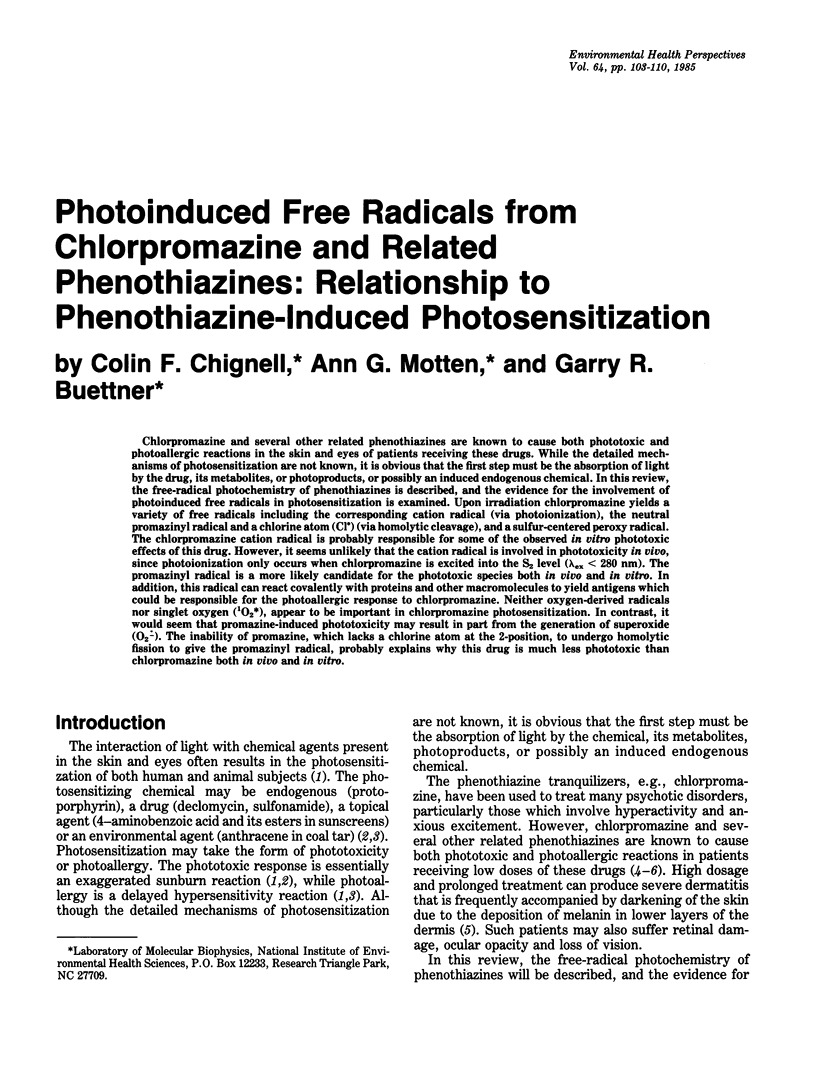
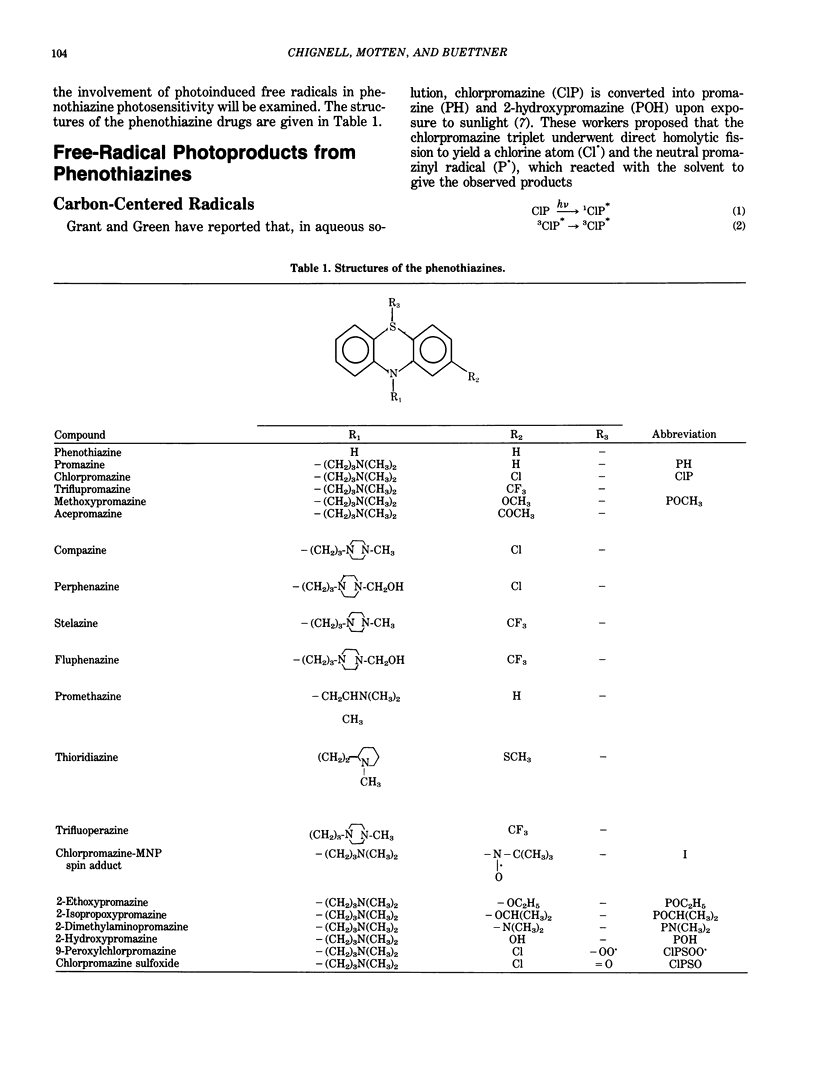
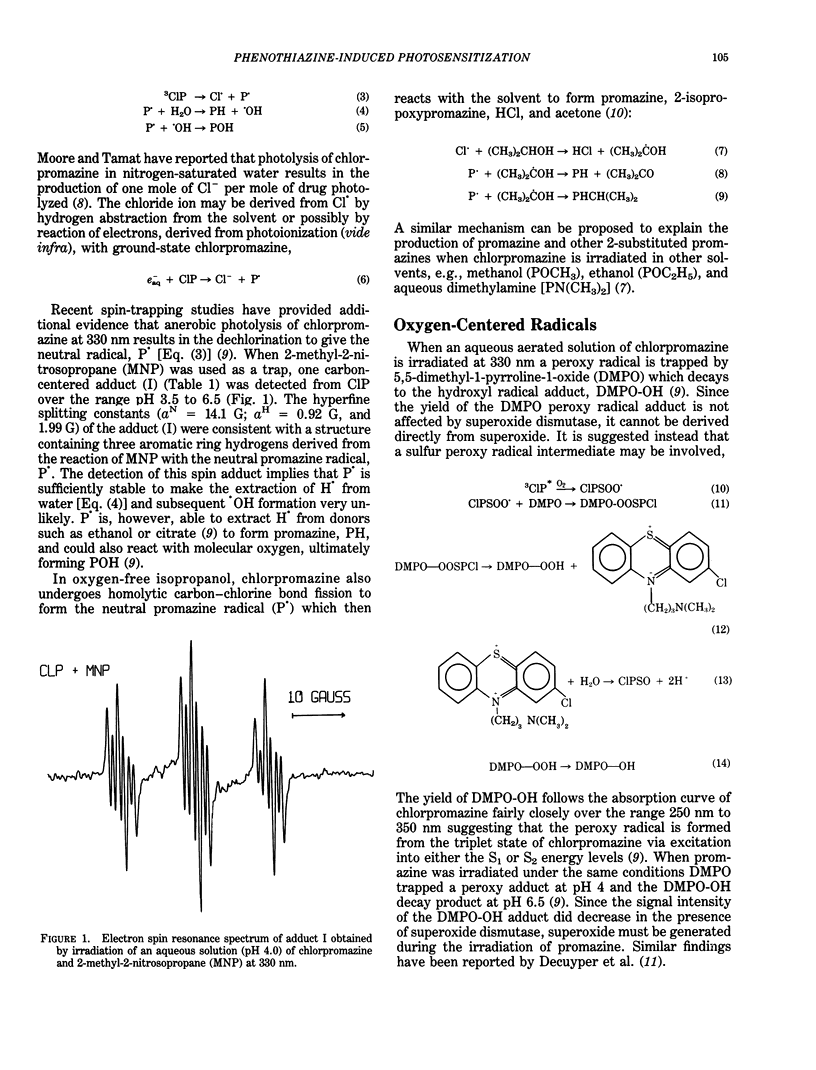
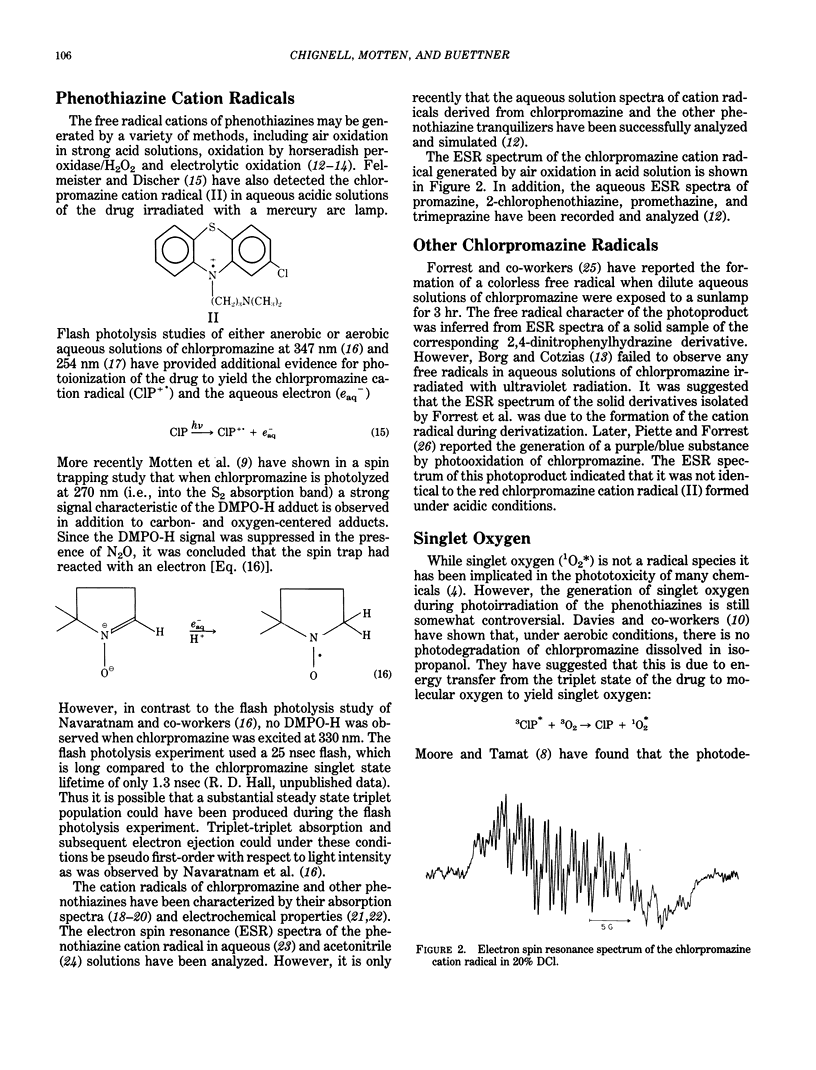
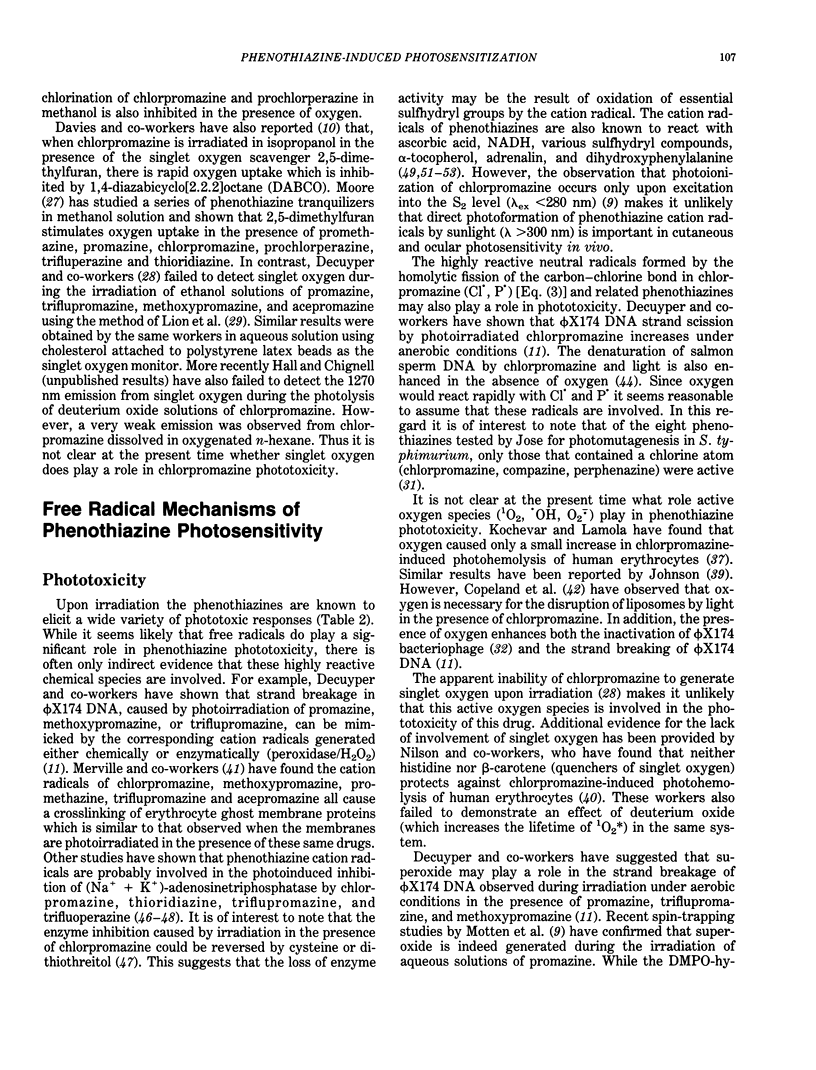
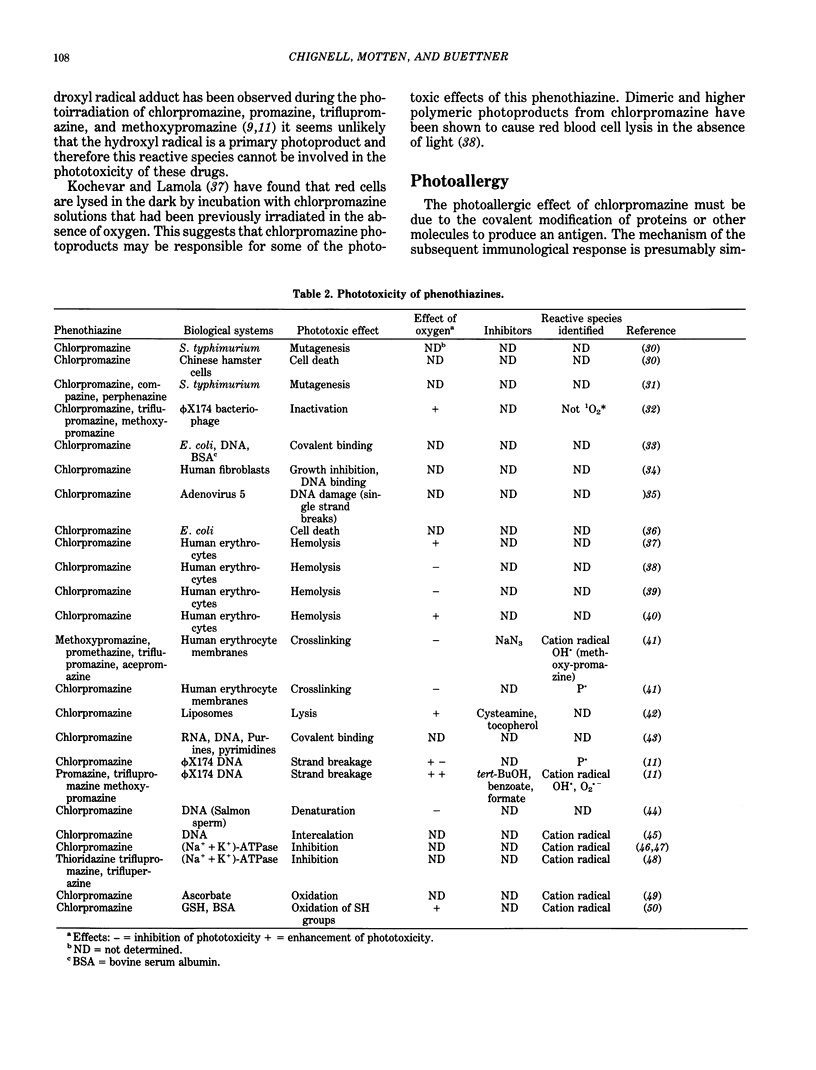
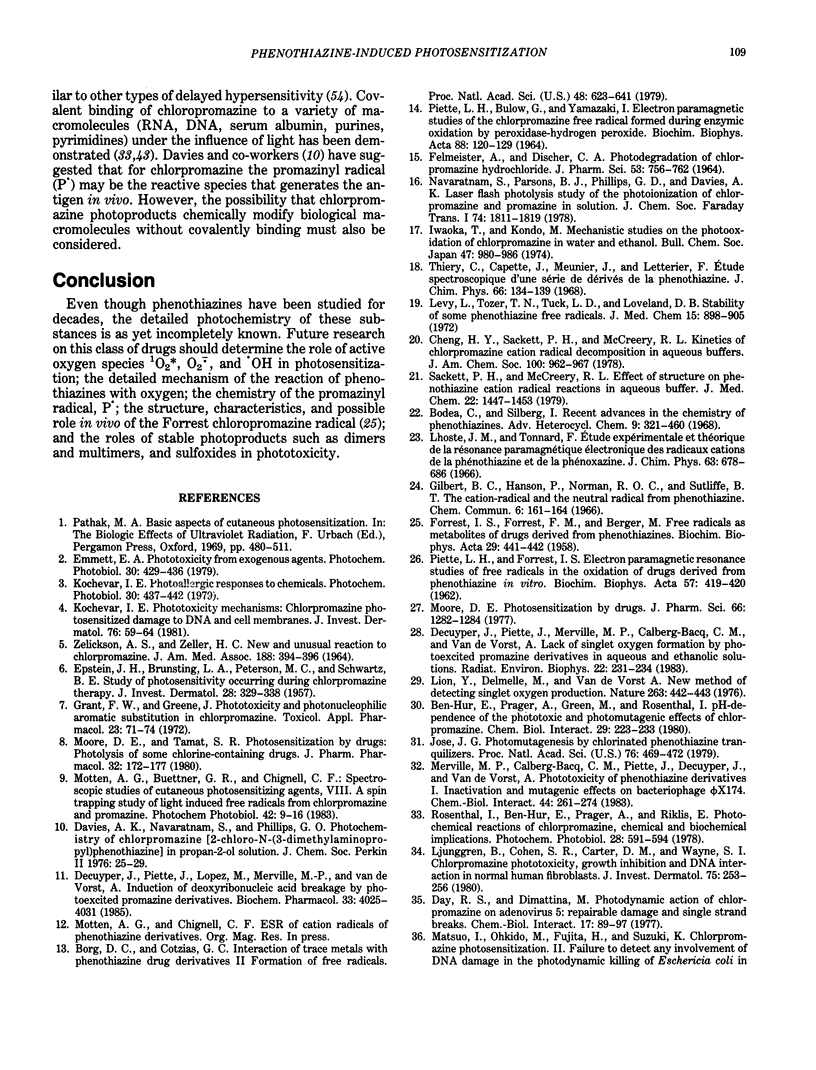
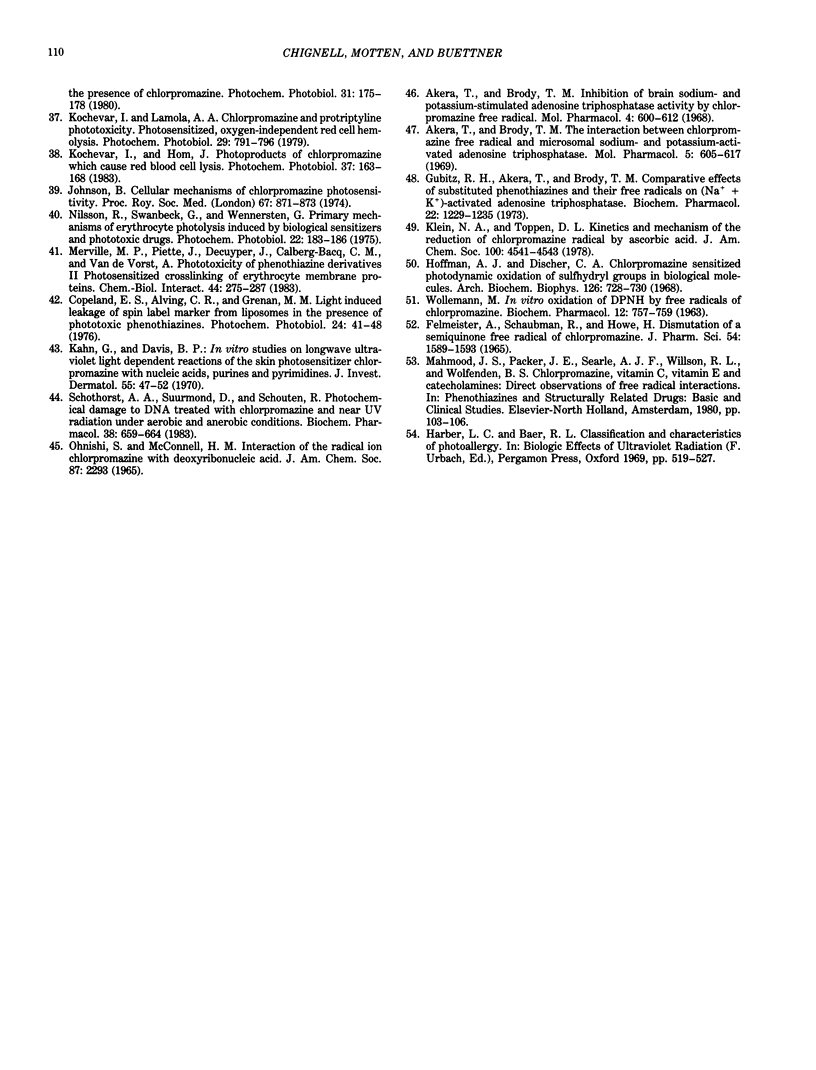
Selected References
These references are in PubMed. This may not be the complete list of references from this article.
- Akera T., Brody T. M. Inhibition of brain sodium- and potassium-stimulated adenosine triphosphatase activity by chlorpromazine free radical. Mol Pharmacol. 1968 Nov;4(6):600–612. [PubMed] [Google Scholar]
- Akera T., Brody T. M. The interaction between chlorpromazine free radical and microsomal sodium- and potassium-activated adenosine triphosphatase from rat brain. Mol Pharmacol. 1969 Nov;5(6):605–614. [PubMed] [Google Scholar]
- Ben-Hur E., Prager A., Green M., Rosenthal I. pH dependence of the phototoxic and photomutagenic effects of chlorpromazine. Chem Biol Interact. 1980 Feb;29(2):223–233. doi: 10.1016/0009-2797(80)90035-6. [DOI] [PubMed] [Google Scholar]
- Bodea C., Silberg I. Recent advances in the chemistry of phenothiazines. Adv Heterocycl Chem. 1968;9:321–460. doi: 10.1016/s0065-2725(08)60375-x. [DOI] [PubMed] [Google Scholar]
- Copeland E. S., Alving C. R., Grenan M. M. Light-induced leakage of spin label marker from liposomes in the presence of phototoxic phenothiazines. Photochem Photobiol. 1976 Jul;24(1):41–48. doi: 10.1111/j.1751-1097.1976.tb06795.x. [DOI] [PubMed] [Google Scholar]
- Day R. S., 3rd, Dimattina M. Photodynamic action of chlorpromazine on adenovirus 5:repairable damage and single strand breaks. Chem Biol Interact. 1977 Apr;17(1):89–97. doi: 10.1016/0009-2797(77)90074-6. [DOI] [PubMed] [Google Scholar]
- Decuyper J., Piette J., Lopez M., Merville M. P., van De Vorst A. Induction of breaks in deoxyribonucleic acid by photoexcited promazine derivatives. Biochem Pharmacol. 1984 Dec 15;33(24):4025–4031. doi: 10.1016/0006-2952(84)90016-9. [DOI] [PubMed] [Google Scholar]
- Decuyper J., Piette J., Merville M. P., Calberg-Bacq C. M., Van de Vorst A. Lack of singlet oxygen formation by photoexcited promazine derivatives in aqueous and ethanolic solutions. Radiat Environ Biophys. 1983;22(3):231–234. doi: 10.1007/BF01323713. [DOI] [PubMed] [Google Scholar]
- EPSTEIN J. H., BRUNSTING L. A., PETERSEN M. C., SCHWARZ B. E. A study of photosensitivity occurring with chlorpromazine therapy. J Invest Dermatol. 1957 May;28(5):329–338. doi: 10.1038/jid.1957.44. [DOI] [PubMed] [Google Scholar]
- Emmett E. A. Phototoxicity from exogenous agents. Photochem Photobiol. 1979 Oct;30(4):429–436. doi: 10.1111/j.1751-1097.1979.tb07159.x. [DOI] [PubMed] [Google Scholar]
- FELMEISTER A., DISCHER C. A. PHOTODEGRADATION OF CHLORPROMAZINE HYDROCHLORIDE. J Pharm Sci. 1964 Jul;53:756–762. doi: 10.1002/jps.2600530712. [DOI] [PubMed] [Google Scholar]
- FORREST I. S., FORREST F. M., BERGER M. Free radicals as metabolites of drugs derived from phenothiazine. Biochim Biophys Acta. 1958 Aug;29(2):441–442. doi: 10.1016/0006-3002(58)90212-9. [DOI] [PubMed] [Google Scholar]
- Grant F. W., Greene J. Phototoxicity and photonucleophilic aromatic substitution in chlorpromazine. Toxicol Appl Pharmacol. 1972 Sep;23(1):71–74. doi: 10.1016/0041-008x(72)90205-0. [DOI] [PubMed] [Google Scholar]
- Gubitz R. H., Akera T., Brody T. M. Comparative effects of substituted phenothiazines and their free radicals on (Na =, K + )-activated adenosine triphosphatase. Biochem Pharmacol. 1973 May 15;22(10):1229–1235. doi: 10.1016/0006-2952(73)90240-2. [DOI] [PubMed] [Google Scholar]
- Hoffman A. J., Discher C. A. Chlorpromazine sensitized photodynamic oxidation of sulfhydryl groups in biological molecules. Arch Biochem Biophys. 1968 Aug;126(2):728–730. doi: 10.1016/0003-9861(68)90462-1. [DOI] [PubMed] [Google Scholar]
- Holland I. M., Kendall B. E. Computed tomography in Alexander's disease. Neuroradiology. 1980;20(2):103–106. doi: 10.1007/BF00339556. [DOI] [PubMed] [Google Scholar]
- Johnson B. E. Cellular mechanisms of chlorpromazine photosensitivity. Proc R Soc Med. 1974 Sep;67(9):871–873. doi: 10.1177/003591577406700922. [DOI] [PMC free article] [PubMed] [Google Scholar]
- Jose J. G. Photomutagenesis by chlorinated phenothiazine tranquilizers. Proc Natl Acad Sci U S A. 1979 Jan;76(1):469–472. doi: 10.1073/pnas.76.1.469. [DOI] [PMC free article] [PubMed] [Google Scholar]
- Kahn G., Davis B. P. In vitro studies on longwave ultraviolet light-dependent reactions of the skin photosensitizer chlorpromazine with nucleic acids, purines and pyrimidines. J Invest Dermatol. 1970 Jul;55(1):47–52. doi: 10.1111/1523-1747.ep12290532. [DOI] [PubMed] [Google Scholar]
- Kochevar I. E., Hom J. Photoproducts of chlorpromazine which cause red blood cell lysis. Photochem Photobiol. 1983 Feb;37(2):163–168. doi: 10.1111/j.1751-1097.1983.tb04452.x. [DOI] [PubMed] [Google Scholar]
- Kochevar I. E., Lamola A. A. Chlorpromazine and protriptyline phototoxicity: photosensitized, oxygen independent red cell hemolysis. Photochem Photobiol. 1979 Apr;29(4):791–796. doi: 10.1111/j.1751-1097.1979.tb07768.x. [DOI] [PubMed] [Google Scholar]
- Kochevar I. E. Photoallergic responses to chemicals. Photochem Photobiol. 1979 Oct;30(4):437–442. doi: 10.1111/j.1751-1097.1979.tb07160.x. [DOI] [PubMed] [Google Scholar]
- Kochevar K. E. Phototoxicity mechanisms: chlorpromazine photosensitized damage to DNA and cell membranes. J Invest Dermatol. 1981 Jul;77(1):59–64. doi: 10.1111/1523-1747.ep12479244. [DOI] [PubMed] [Google Scholar]
- Levy L., Tozer T. N., Tuck L. D., Loveland D. B. Stability of some phenothiazine free radicals. J Med Chem. 1972 Sep;15(9):898–905. doi: 10.1021/jm00279a006. [DOI] [PubMed] [Google Scholar]
- Lion Y., Delmelle M., van de Vorst A. New method of detecting singlet oxygen production. Nature. 1976 Sep 30;263(5576):442–443. doi: 10.1038/263442a0. [DOI] [PubMed] [Google Scholar]
- Ljunggren B., Cohen S. R., Carter D. M., Wayne S. I. Chlorpromazine phototoxicity: growth inhibition and DNA-interaction in normal human fibroblasts. J Invest Dermatol. 1980 Sep;75(3):253–256. doi: 10.1111/1523-1747.ep12523279. [DOI] [PubMed] [Google Scholar]
- Merville M. P., Calberg-Bacq C. M., Piette J., Decuyper J., van de Vorst A. Phototoxicity of phenothiazine derivatives. I. Inactivating and mutagenic effects on bacteriophage øX174. Chem Biol Interact. 1983 Jun;44(3):261–274. doi: 10.1016/0009-2797(83)90054-6. [DOI] [PubMed] [Google Scholar]
- Merville M. P., Piette J., Decuyper J., Calberg-Bacq C. M., van de Vorst A. Phototoxicity of phenothiazine derivatives. II. Photosensitized cross-linking of erythrocyte membrane proteins. Chem Biol Interact. 1983 Jun;44(3):275–287. doi: 10.1016/0009-2797(83)90055-8. [DOI] [PubMed] [Google Scholar]
- Moore D. E. Photosensitization by drugs. J Pharm Sci. 1977 Sep;66(9):1282–1284. doi: 10.1002/jps.2600660919. [DOI] [PubMed] [Google Scholar]
- Moore D. E., Tamat S. R. Photosensitization by drugs: photolysis of some chlorine-containing drugs. J Pharm Pharmacol. 1980 Mar;32(3):172–177. doi: 10.1111/j.2042-7158.1980.tb12884.x. [DOI] [PubMed] [Google Scholar]
- Motten A. G., Buettner G. R., Chignell C. F. Spectroscopic studies of cutaneous photosensitizing agents--VIII. A spin-trapping study of light induced free radicals from chlorpromazine and promazine. Photochem Photobiol. 1985 Jul;42(1):9–15. doi: 10.1111/j.1751-1097.1985.tb03540.x. [DOI] [PubMed] [Google Scholar]
- Nilsson R., Swanbeck G., Wennersten G. Primary mechanisms of erythrocyte photolysis induced by biological sensitizers and phototoxic drugs. Photochem Photobiol. 1975 Nov;22(5):183–186. doi: 10.1111/j.1751-1097.1975.tb06734.x. [DOI] [PubMed] [Google Scholar]
- OHNISHI S. I., MCCONNELL H. M. INTERACTION OF THE RADICAL ION OF CHLORPROMAZINE WITH DEOXYRIBONUCLEIC ACID. J Am Chem Soc. 1965 May 20;87:2293–2293. doi: 10.1021/ja01088a040. [DOI] [PubMed] [Google Scholar]
- PIETTE L. H., BULOW G., YAMAZAKI I. ELECTRON-PARAMAGNETIC-RESONANCE STUDIES OF THE CHLORPROMAZINE FREE RADICAL FORMED DURING ENZYMIC OXIDATION BY PEROXIDASE-HYDROGEN PEROXIDE. Biochim Biophys Acta. 1964 Jul 29;88:120–129. doi: 10.1016/0926-6577(64)90160-3. [DOI] [PubMed] [Google Scholar]
- PIETTE L. H., FORREST I. S. Electron paramagnetic resonance studies of free radicals in the oxidation of drugs derived from phenothiazine in vitro. Biochim Biophys Acta. 1962 Feb 26;57:419–420. doi: 10.1016/0006-3002(62)91150-2. [DOI] [PubMed] [Google Scholar]
- Rosenthal I., Ben-Hur E., Prager A., Riklis E. Photochemical reactions of chlorpromazine; chemical and biochemical implications. Photochem Photobiol. 1978 Oct-Nov;28(4-5):591–594. doi: 10.1111/j.1751-1097.1978.tb06975.x. [DOI] [PubMed] [Google Scholar]
- Sackett P. H., McCreery R. L. Effect of structure on phenothiazine cation radical reactions in aqueous buffers. J Med Chem. 1979 Dec;22(12):1447–1453. doi: 10.1021/jm00198a004. [DOI] [PubMed] [Google Scholar]
- Schothorst A. A., Suurmond D., Schouten R. Photochemical damage to DNA treated with chlorpromazine and near UV radiation under aerobic and anaerobic conditions. Photochem Photobiol. 1983 Dec;38(6):659–664. doi: 10.1111/j.1751-1097.1983.tb03597.x. [DOI] [PubMed] [Google Scholar]
- WOLLEMANN M. In vitro oxidation of DPNH by free radicals of chlorpromazine. Biochem Pharmacol. 1963 Jul;12:757–759. doi: 10.1016/0006-2952(63)90050-9. [DOI] [PubMed] [Google Scholar]
- ZELICKSON A. S., ZELLER H. C. A NEW AND UNUSUAL REACTION TO CHLORPROMAZINE. JAMA. 1964 Apr 27;188:394–396. doi: 10.1001/jama.1964.03060300056018. [DOI] [PubMed] [Google Scholar]


